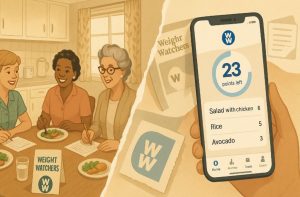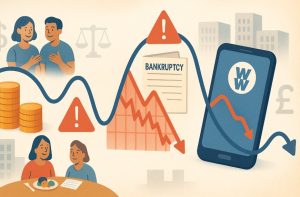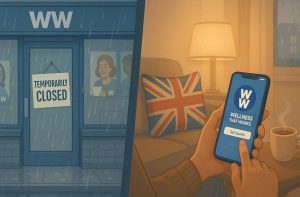In 2024, reports emerged that WW International, the company formerly known as Weight Watchers was preparing to file for bankruptcy. Once a staple in the weight loss industry, WW is now grappling with mounting financial troubles, shifting consumer behaviours, and increased competition from pharmaceutical solutions and digital health platforms.
So, what’s really happening? Is Weight Watchers going out of business or is it undergoing a radical transformation?
What Is Weight Watchers?

Founded in 1963 by Jean Nidetch, Weight Watchers began as a community-driven programme to help people lose weight through accountability and shared experience. Over the years, it became globally recognised for its structured points system, in-person meetings, and branded food products.
In 2018, it rebranded as WW International, signalling a pivot toward holistic wellness under the tagline “Wellness that Works”. The move reflected broader changes in the health industry, where mental wellbeing and lifestyle habits started to take centre stage.
Where Does Weight Watchers Stand in the Wellness Industry Today?
WW continues to offer services across the globe, including in the UK. However, the brand now operates in a drastically different landscape. The wellness industry is dominated by mobile apps, telehealth, and pharmaceutical interventions like Ozempic and Wegovy which are reshaping consumer expectations around weight loss.
WW’s attempts to keep up, like launching its WW+ app and acquiring telehealth provider Sequence reflect a broader identity crisis. The company is caught between its past legacy and the demands of a digital-first, clinically-focused future.
How Has Weight Watchers’ Financial Performance and Business Model Changed?

Revenues in Decline
WW’s financial problems have escalated in 2024, with revenues dropping by $104 million (approximately £83 million) to $786 million (£629 million). It also faces over $1.4 billion (£1.12 billion) in loans and bonds due in 2028 and 2029.
In February 2024, S&P Global downgraded WW’s credit rating after it drew down the full $175 million (£140 million) of its revolving credit facility. The agency warned that WW may default within the next six months, either through bankruptcy or out-of-court restructuring.
Preparing for Bankruptcy
According to The Wall Street Journal, WW is actively preparing for Chapter 11 bankruptcy proceedings. This would hand control of the business to creditors and mark a dramatic turning point for the brand.
From Community to Clinical Strategy
While WW was once known for its communal weight-loss meetings, its modern strategy includes integrating GLP-1 medications like semaglutide (Ozempic) into its services. However, this shift has not reversed the company’s declining subscription numbers or financial stability.
What Are the Main Challenges Weight Watchers Is Facing in 2024?
Rising Competition from Apps and Medications
The surge in popularity of drugs like Ozempic and Wegovy has created a pharmaceutical alternative to traditional weight-loss programmes. Many consumers now prefer medication-based solutions to diet and lifestyle changes.
At the same time, tech-savvy competitors like Noom offer behaviour-focused weight loss through sleek, user-friendly apps. WW’s attempt to keep pace with digital innovations has struggled to attract a younger audience.
Changing Cultural Narratives
Weight Watchers’ foundational model of food points and weekly weigh-ins is increasingly out of step with modern views on body image, mental health, and diet culture. Millennials and Gen Z are driving demand for intuitive eating, mental wellness, and sustainable habits—shifting away from structured diets entirely.
What Major Internal Changes Have Affected Weight Watchers Recently?
Oprah Winfrey’s Exit
A long-time spokesperson and board member, Oprah Winfrey stepped down in 2023 after nearly a decade of association with the brand. Her announcement that she had used weight-loss medication as a maintenance tool symbolised the shift away from lifestyle programmes like WW towards pharmaceutical solutions.
Loss of Identity
With its business model under threat and revenue declining, WW’s attempt to rebrand as a digital health platform has created confusion about what it stands for. While its app now includes meditation, sleep tracking, and coaching, it lacks the unique emotional appeal that once defined the brand.
What’s the Current Situation for Weight Watchers in the UK?

Digital Over Physical
In the UK, WW has reduced its physical presence significantly. Most community workshops have closed, with services now offered almost entirely through the WW app. While this reflects global trends, it’s alienated long-time members who valued in-person connection.
Declining UK Engagement
Though specific numbers are not publicly available, reports suggest a decline in UK membership. Older users once the core audience have been slower to adopt digital-only programmes, especially as the community element of WW fades.
Is Weight Watchers Still Relevant in Today’s Health and Wellness Market?
WW has tried to stay relevant by embracing the future of wellness acquiring Sequence, offering GLP-1 medication support, and shifting fully to digital platforms. However, the move raises a critical question:
When a company built on shared struggle becomes a clinical service, what is lost?
While the convenience of telehealth appeals to modern consumers, research shows that digital programmes often lack the emotional engagement and accountability found in in-person support. The warmth, humour, and connection of WW meetings are difficult to replicate in an app.
What Key Events Have Shaped Weight Watchers’ Recent Business Trajectory?
| Year | Event | Impact |
| 2022 | Launch of WW+ App | Digital pivot and mobile-first strategy |
| 2023 | Oprah exits WW board | Public trust decline and stock market hit |
| 2024 | Bankruptcy preparation reported | Signals potential corporate restructuring |
| 2024 | Semaglutide integration | Shift towards pharmaceutical care model |
Is Weight Watchers Going Out of Business or Simply Evolving?
WW is not vanishing overnight, but it’s undeniably in crisis. Its model built on community, accountability, and shared goals—is at odds with a modern wellness industry now driven by pharmaceuticals, artificial intelligence, and instant results.
The looming bankruptcy and financial restructuring mark more than just corporate upheaval; they represent the end of an era. WW’s legacy was about people helping people. Today, that space is being replaced by convenience, algorithms, and clinical solutions.
And as we move forward into the age of AI diets and subscription apps, we must ask ourselves:
What are we losing when the meeting rooms go empty?
FAQs
Why is Weight Watchers filing for bankruptcy?
WW is facing over $1.4 billion in debt and declining revenue, prompting it to prepare for Chapter 11 bankruptcy and potential restructuring.
What does bankruptcy mean for WW users in the UK?
Digital services will likely continue, but any in-person or physical operations may be reduced further.
Is WW still offering weight loss support with medications?
Yes, through its acquisition of Sequence, WW now provides access to telehealth prescriptions for GLP-1 medications like Ozempic.
How has WW’s business model changed?
It’s shifted from in-person support to a digital-first approach, integrating coaching, tracking, and medication into its app.
Why are younger consumers turning away from WW?
Younger users prefer intuitive eating, flexible health strategies, and digital solutions that feel more modern and personalised.
Is the WW app effective for weight loss?
It can be effective for motivated users, but many studies show that in-person support remains more sustainable for long-term weight loss.
What made Weight Watchers so successful in the past?
Its community-based meetings, structured programme, and emotional support helped people stay accountable and feel understood.




